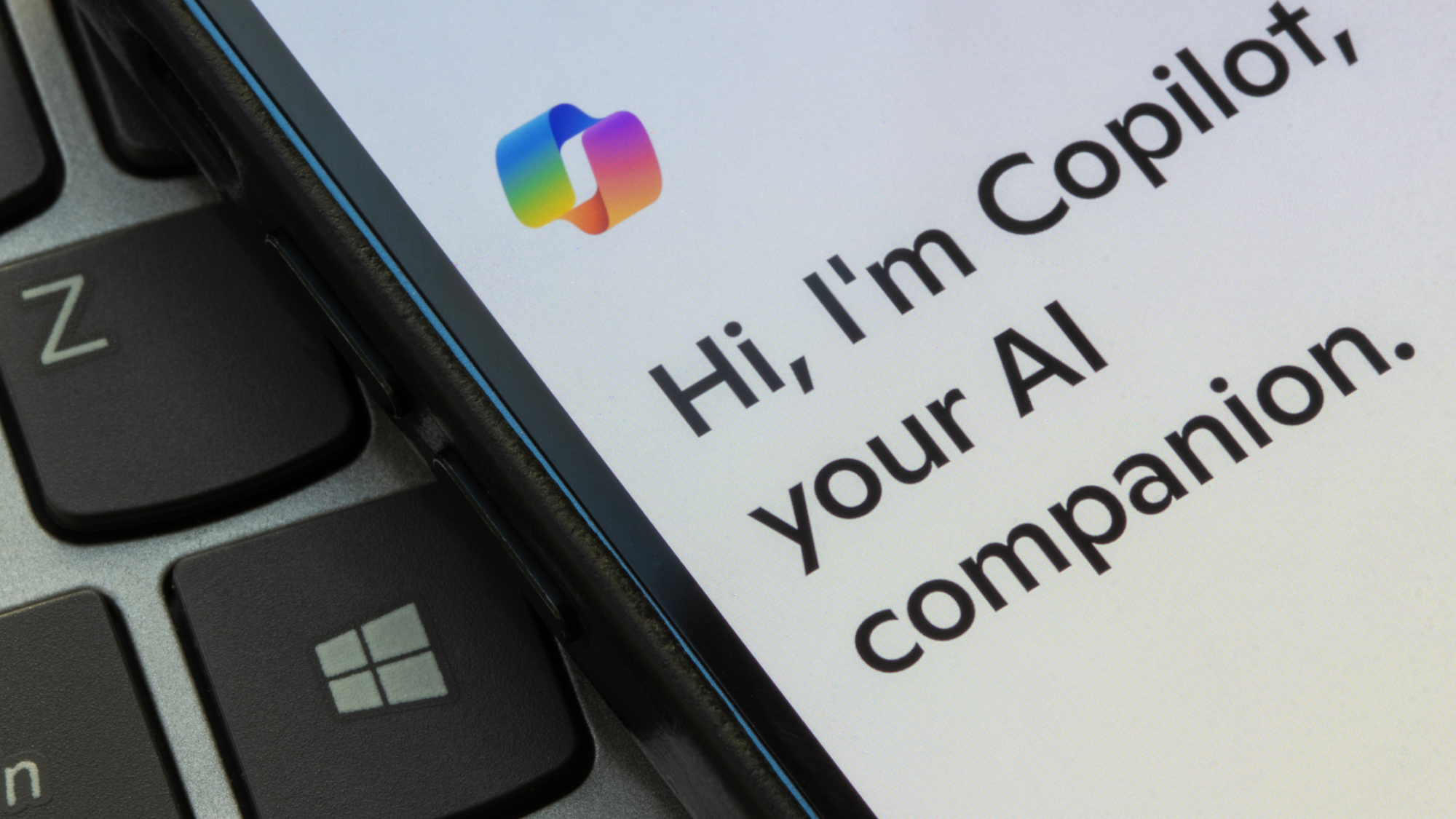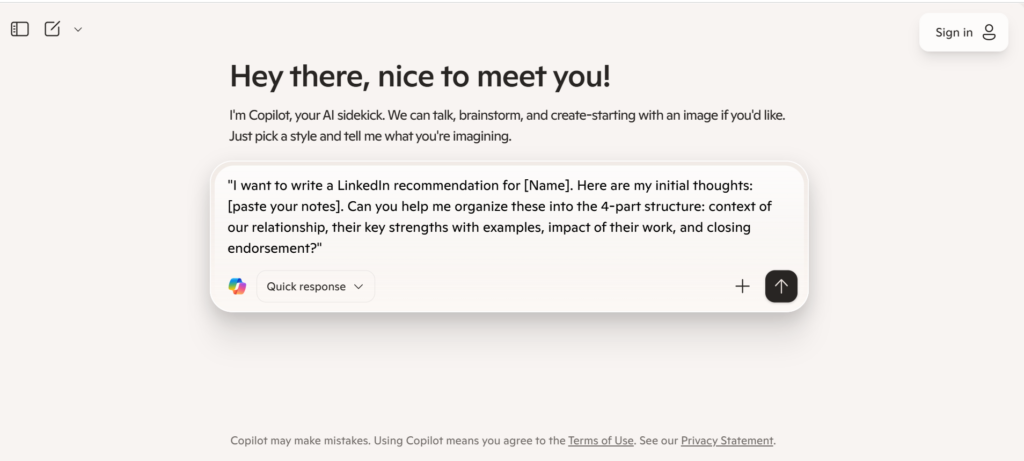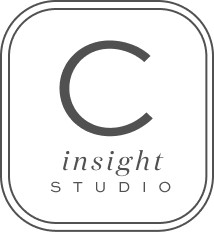As a follow-up to last week’s 4-part formula for writing authentic LinkedIn recommendations, this post explores how to leverage AI tools to overcome writer’s block and streamline your process (while keeping the genuine, personal touch that makes recommendations truly valuable).

Let’s be honest, even with a clear structure for writing LinkedIn recommendations, staring at that blank text box can still feel a bit daunting. That’s where AI tools can become your secret weapon (not to replace your authentic voice, but to help you organize your thoughts and overcome writer’s block).
Here’s how to leverage AI tools to enhance your recommendation writing process while keeping it genuine and personal.
AI as Your Writing Assistant, Not Your Writer
The key to using AI effectively is treating it as a brainstorming partner and editor, not a replacement for your authentic voice. Here’s the approach:
Step 1: Gather Your Thoughts First
Before touching any AI tool, spend 5 minutes collecting your thoughts:
- How do you know this person?
- What specific project or situation comes to mind?
- What qualities made them great to work with?
- What was the impact of their work?
Step 2: Use AI to Structure and Refine
If you haven’t experimented with any of the AI tools yet, there are great free options to try it out! The AI tools I have had the best experience with so far are ChatGPT, Claude, and Microsoft 365 Copilot.
Once you choose your AI tool, here are some prompts you can copy/paste to get started:
For organizing your thoughts:
“I want to write a LinkedIn recommendation for [Name]. Here are my initial thoughts: [paste your notes]. Can you help me organize these into the 4-part structure: context of our relationship, their key strengths with examples, impact of their work, and closing endorsement?”

For overcoming specific blocks:
“I’m writing a LinkedIn recommendation for someone who [describe their role/contribution]. I know they were excellent at [specific skill], but I’m struggling to describe it professionally. Can you suggest 2-3 ways to phrase this strength?”
For tone adjustment:
“Here’s my draft LinkedIn recommendation. Can you help me make it sound more [professional/warm/specific] while keeping my authentic voice?”
Step 3: The “Authenticity Check”
After AI helps you draft or refine the recommendation, ask yourself:
- Does this sound like something I would actually say?
- Would the person I’m recommending recognize these examples?
- Am I being specific enough that sounds credible and not generic?
If the answer is no to any of these, revise to add more of your personal perspective.
Specific AI Prompts to Use
For Each Part of the 4-Part Formula:
Opening (Context):
“I worked with [Name] as [relationship] at [Company]. Help me write a more engaging opening line that establishes this context professionally.”
Strengths & Examples:
“I want to highlight that [Name] is great at [skill/quality]. Here’s what I observed: [specific situation]. Help me describe this more compellingly while staying factual.”
Impact:
“The result of [Name]’s work was [outcome]. Help me articulate why this mattered to our team/company/clients in a way that shows real impact.”
Closing:
“I want to end with genuine appreciation for [Name]. Based on what I’ve shared, suggest 2-3 authentic closing lines that feel warm but professional.”
What AI Tools Excel At (And Where They Fall Short)
AI Strengths:
- Grammar and flow: Polishing awkward sentences
- Professional tone: Finding the right level of formality
- Structure: Organizing scattered thoughts coherently
- Variety: Suggesting different ways to phrase the same idea
- Confidence: Helping you sound more decisive in your praise
AI Limitations:
- Specificity: It can’t know the inside details of your working relationship
- Authenticity: Generic praise feels hollow or insincere
- Context: It doesn’t understand your company culture or industry nuances
- Emotion: Real gratitude and appreciation come from your experience
Advanced AI Strategies
The “Interview Method”
Use AI to interview you about your experience:
“Ask me 5 questions that would help me write a strong LinkedIn recommendation for a former colleague. Base the questions on what would make the recommendation most helpful for their career.”
The “Perspective Shift”
“I’m recommending [Name] for [type of role they’re seeking]. What aspects of their work should I emphasize to make this recommendation most valuable for that career direction?”
The “Red Flag Check”
“Review this LinkedIn recommendation draft. Are there any phrases that sound generic, overly promotional, or potentially problematic for a professional context?”
Common Pitfalls to Avoid
- The Template Trap: Don’t use AI to generate a complete recommendation from scratch—it will likely sound too generic. And know that AI tools like to use em dashes so even though you like using them, it may give the impression that your context was created with AI if you use them.
- Buzzword Overload: AI often suggests corporate jargon. Ask for “simpler, more direct language” if this happens.
- Length Creep: AI can make recommendations too verbose. If that’s the case, you can ask to “condense this to under 200 words while keeping the key points.”
- Lost Voice: If your draft doesn’t sound like you, it’s time to inject more personal details and genuine emotion.
AI tools are incredibly powerful for overcoming the blank page problem and polishing your thoughts into professional language. But the heart of a great LinkedIn recommendation are the specific examples, genuine appreciation, and personal insight. That still comes from you 😉
Remember: the best LinkedIn recommendations aren’t the most perfectly written ones—they’re the ones that feel real and help someone else’s career. AI can help you get there faster, but your authentic experience is what makes it valuable.
Ready to Try It?
Pick someone from your network who deserves recognition. Spend 5 minutes capturing your genuine thoughts about working with them, then use AI to help you turn those thoughts into a polished recommendation. You’ll be surprised how much easier the process becomes when you let AI handle the structure while you focus on the substance.
Thanks for reading and sharing! xx




Excellent tips! Not everybody has a flair for writing or understanding the strategic marketing intent that accompanies a great recommendation.
Having a partner in the journey that can help guide and refine your heart, and your language is a real benefit.
100%!